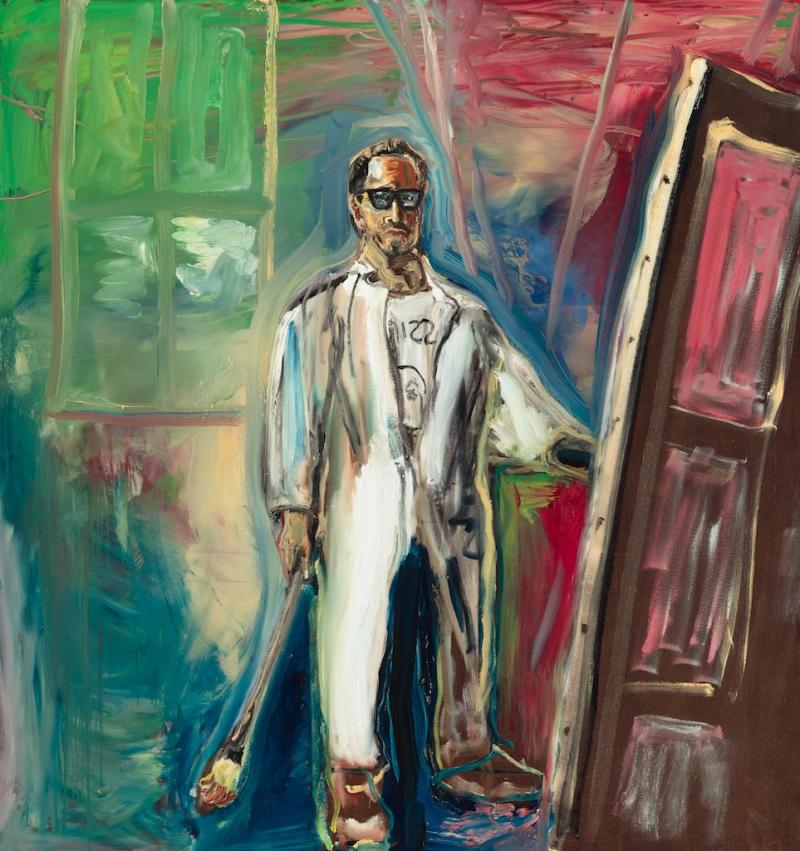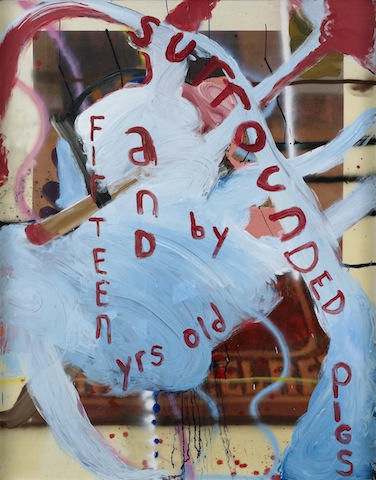Julian Schnabel: Every Angel has a Dark Side, Dairy Art Centre | reviews, news & interviews
Julian Schnabel: Every Angel has a Dark Side, Dairy Art Centre
Julian Schnabel: Every Angel has a Dark Side, Dairy Art Centre
The American painter-turned-filmmaker shows another raft of bad expressionist paintings

“Occasionally, but rarely, great imaginative leaps take place in the progression of art that seem to have come from nowhere. This can be said of Julian Schnabel….In these early paintings Schnabel worked with materials on surfaces that had never been used before....The sheer originality of Schnabel’s vision struck the art world explosively.”
So writes curator David Thorp in a catalogue essay for this exhibition. And the solemnly vacuous puff continues: “But as with all momentous changes in art these inevitably created as much criticism as acclaim.”
Let me begin by saying this. I’ve come to these paintings, painted over the course of a decade, knowing all about the praise and the opprobrium heaped on Schnabel’s earlier paintings, in the days when he was seen as the rich bad boy of the Eighties New York art scene. I’ve come to them knowing that Schnabel once compared himself to Picasso. Neither of these things matter. That is to say, they matter only in as much as they’ve bought me to this exhibition in the first place, but no more. Fame and notoriety – who said what, and for how much his paintings once sold – can only do so much of the work.
Like a lot of bad painting they all look much better in reproduction
And of course, one must be as happy to disregard the strutting utterances of artists as they are the eloquent vitriol of damning critics (one thinks of Robert Hughes’ scathing Schnabel put-downs). In the same vein, one must disregard too the hyperventilated utterances of curators such as Thorp, who, it appears, in order to correct earlier critical drubbings, have gone to bewildering extremes of praise. Since he talks of “great imaginative leaps” that change the landscape of art as we know it, should we expect Giotto, Michelangelo and Picasso rolled into one?
One would seriously think that no artist had ever used unconventional objects in a painting before (in Schnabel’s case, broken plates). All I can say is that you couldn’t pay me enough to make half the claims Thorp makes for Schnabel’s originality and genius. On show here are some very bad paintings, but if one must really claim that white is black and black is white, one would wish it to be for a better cause than Schnabel’s ego and a writer’s cheque.
There are a number of ways a work of art can be described as bad, but I'll discount what I don't mean here. I don’t mean Schnabel’s paintings are bad because of limited technical range or facility, since limited technical range and facility don't necessarily result in bad work. Nor has it much to do with disliking a kind of late postmodern aesthetic characterised by vulgarity, showiness or sentimentality, à la Jeff Koons’ porn pictures or his dopey puppies. Nor is Schnabel “bad” in that faux-naïf sense popular among painters of the Eighties and Nineties. To make a good “bad” painting you still have to be alert to many of the things that make an ordinarily good painting, not least in terms of composition and balance.
No. What I mean is that looking at Schnabel’s bad painting is simply akin to the experience of reading a bad book. A really bad book whose every sentence labours not only under the ponderous weight of its own importance but under a glut of adjectives and adverbs. You long to strip and to edit as you’re reading, to rescue the writing from its own undisciplined verbosity, its bloated yet acutely naïve sense of itself. But you have a suspicion that no amount of editing will do the job, since each sentiment is a banal generality – a hoary cliché – rather than a striking insight.
 Thorp writes that “for Schnabel a painting is finished when there’s enough information in it.” Well, Schnabel certainly throws a lot into these 18 flatulent paintings, employing a variety of techniques but to little coherent effect. Some of them, the self-portraits – in one he appears in luxury pyjamas unbuttoned down to his waist (pictured right) – together with the paintings featuring an unnamed artist at his easel, remind me of Munch. Very bad Munch. Schnabel seems to want to convey some very uninteresting idea about the artist as heroic loner, confronting himself as he physically confronts and paints his own image. I look for humour as the one redeeming feature that might rescue these paintings from their overweening pomposity but humour, being a fragile thing, could clearly never survive this atmosphere of bluster. Like a lot of bad painting they all look much better in reproduction.
Thorp writes that “for Schnabel a painting is finished when there’s enough information in it.” Well, Schnabel certainly throws a lot into these 18 flatulent paintings, employing a variety of techniques but to little coherent effect. Some of them, the self-portraits – in one he appears in luxury pyjamas unbuttoned down to his waist (pictured right) – together with the paintings featuring an unnamed artist at his easel, remind me of Munch. Very bad Munch. Schnabel seems to want to convey some very uninteresting idea about the artist as heroic loner, confronting himself as he physically confronts and paints his own image. I look for humour as the one redeeming feature that might rescue these paintings from their overweening pomposity but humour, being a fragile thing, could clearly never survive this atmosphere of bluster. Like a lot of bad painting they all look much better in reproduction.
And they are big. Massive, with their opulent frames slathered in beige paint. A few have a thick layer of gloss resin, making their surfaces hard and glassy, like heavily lacquered furniture. Indeed, one thinks that Chinese dressers may have been the inspiration for this, since another series of paintings has an “oriental” theme. Images from old Zen paintings have been digitally printed on polyester, onto which Schnabel has intervened with florid expressionistic streaks and smears, writing BEZ in big graffiti letters on one, in homage to the Happy Mondays.
 Another painting in which text appears apparently expresses his anger at the way young models are treated in the fashion industry. Fifteen Yrs Old and Surrounded By Pigs (pictured left) is an ectoplasmic explosion of dirty white paint edged with liverish pink with the words of the title floating like spaghetti letters on its surface. In fact, this is probably the only painting I like. It suggests a kind of gargantuan comic adolescent rage eating itself. Forget those other bombastic self-portraits – this is probably the only revealing one.
Another painting in which text appears apparently expresses his anger at the way young models are treated in the fashion industry. Fifteen Yrs Old and Surrounded By Pigs (pictured left) is an ectoplasmic explosion of dirty white paint edged with liverish pink with the words of the title floating like spaghetti letters on its surface. In fact, this is probably the only painting I like. It suggests a kind of gargantuan comic adolescent rage eating itself. Forget those other bombastic self-portraits – this is probably the only revealing one.
Explore topics
Share this article
Add comment
The future of Arts Journalism
You can stop theartsdesk.com closing!
We urgently need financing to survive. Our fundraising drive has thus far raised £49,000 but we need to reach £100,000 or we will be forced to close. Please contribute here: https://gofund.me/c3f6033d
And if you can forward this information to anyone who might assist, we’d be grateful.

Subscribe to theartsdesk.com
Thank you for continuing to read our work on theartsdesk.com. For unlimited access to every article in its entirety, including our archive of more than 15,000 pieces, we're asking for £5 per month or £40 per year. We feel it's a very good deal, and hope you do too.
To take a subscription now simply click here.
And if you're looking for that extra gift for a friend or family member, why not treat them to a theartsdesk.com gift subscription?
more Visual arts
 'We are bowled over!' Thank you for your messages of love and support
Much-appreciated words of commendation from readers and the cultural community
'We are bowled over!' Thank you for your messages of love and support
Much-appreciated words of commendation from readers and the cultural community
 Folkestone Triennial 2025 - landscape, seascape, art lovers' escape
Locally rooted festival brings home many but not all global concerns
Folkestone Triennial 2025 - landscape, seascape, art lovers' escape
Locally rooted festival brings home many but not all global concerns
 Sir Brian Clarke (1953-2025) - a personal tribute
Remembering an artist with a gift for the transcendent
Sir Brian Clarke (1953-2025) - a personal tribute
Remembering an artist with a gift for the transcendent
 Emily Kam Kngwarray, Tate Modern review - glimpses of another world
Pictures that are an affirmation of belonging
Emily Kam Kngwarray, Tate Modern review - glimpses of another world
Pictures that are an affirmation of belonging
 Kiefer / Van Gogh, Royal Academy review - a pairing of opposites
Small scale intensity meets large scale melodrama
Kiefer / Van Gogh, Royal Academy review - a pairing of opposites
Small scale intensity meets large scale melodrama
 Jenny Saville: The Anatomy of Painting, National Portrait Gallery review - a protégé losing her way
A brilliant painter in search of a worthwhile subject
Jenny Saville: The Anatomy of Painting, National Portrait Gallery review - a protégé losing her way
A brilliant painter in search of a worthwhile subject
 Abstract Erotic, Courtauld Gallery review - sculpture that is sensuous, funny and subversive
Testing the boundaries of good taste, and winning
Abstract Erotic, Courtauld Gallery review - sculpture that is sensuous, funny and subversive
Testing the boundaries of good taste, and winning
 Edward Burra, Tate Britain review - watercolour made mainstream
Social satire with a nasty bite
Edward Burra, Tate Britain review - watercolour made mainstream
Social satire with a nasty bite
 Ithell Colquhoun, Tate Britain review - revelations of a weird and wonderful world
Emanations from the unconscious
Ithell Colquhoun, Tate Britain review - revelations of a weird and wonderful world
Emanations from the unconscious
 Rachel Jones: Gated Canyons, Dulwich Picture Gallery review - teeth with a real bite
Mouths have never looked so good
Rachel Jones: Gated Canyons, Dulwich Picture Gallery review - teeth with a real bite
Mouths have never looked so good
 Yoshitomo Nara, Hayward Gallery review - sickeningly cute kids
How to make millions out of kitsch
Yoshitomo Nara, Hayward Gallery review - sickeningly cute kids
How to make millions out of kitsch
 Hamad Butt: Apprehensions, Whitechapel Gallery review - cool, calm and potentially lethal
The YBA who didn’t have time to become a household name
Hamad Butt: Apprehensions, Whitechapel Gallery review - cool, calm and potentially lethal
The YBA who didn’t have time to become a household name

Comments
The lead picture says it all.